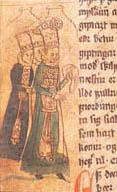 |
 |

Viking Iceland cradle of democracy About the Sagas living literature Vikings in America Project background Publication details Reviews Home |
Viking IcelandThe Cradle of DemocracyThe Settlement of IcelandThe settlement of Iceland, which began around 870, was part of the general expansion of the Viking world. Most of the settlers came from west Norway, but a considerable number were from the British Isles. In this virgin country, the settlers had to adjust to a new and strange environment, with a different climate from the one they were accustomed to, as well as volcanoes and hot springs. Iceland was probably fully settled in the space of around 60 years and its inhabitants had to establish and develop an entirely new society with social institutions and power structures of its own. The resulting tensions between freedom and order, the individual and society, form the essence of the Saga narratives. The AlthingIn 930, more than half a century after settlement of Iceland began, representatives of leading families established a national assembly, the Althing, the oldest of its kind in the world, on the plains at Thingvellir. With no king, this was a unique political structure in the Middle Ages. Meeting for two weeks in high summer each year, the assembly attracted men and women from all around Iceland. Its main role was to pass laws and settle disputes, but with no executive powers, the legal and moral obligation to implement sentences was left to individuals – carrying out this obligation is one of the main themes of the Sagas. The women of the Sagas... are far from being the blushing damsels waiting for a knight in shining armour who typify so many other medieval narratives. Rather, many of them seem more like Antigone and Medea from classical Greek tragedy in their dramatic strength, their staunchness and stoicism, and also in their human failings. Although we invariably find men dominating the foreground of the narrative, the Saga world is also strongly shaped by women: by mothers who instil their sons with ancient heroic values and incite them to noble deeds, by beautiful young women over whose favours poets fight, by women of steely character who rebel against male power and refuse to accept the limitations imposed on them by custom and law. Women play a prominent role in The Saga of the People of Laxardal, whose central character is a woman, Gudrun Osvifsdottir. The depictions of female experience – their rebellions and defeats – are so insightful and revealing in this Saga that some scholars see it as the work of a woman. |
In the Middle Ages, the Icelanders were the historiographers of the North. 
Icelandic manuscripts preserve most of what we know today about North European history and learning during this era; they sketch the outlines of Nordic identity. 
The principal manuscripts are preserved in the Arni Magnusson Manuscript Institute in Reykjavik, where these national treasures are on public display. |
 © 1997 –
Leifur Eiriksson Publishing Ltd.
© 1997 –
Leifur Eiriksson Publishing Ltd.Flokagata 65 – 105 Reykjavik – Iceland Tel: (354) 552-8989 – E-mail: vinland@centrum.is |
||